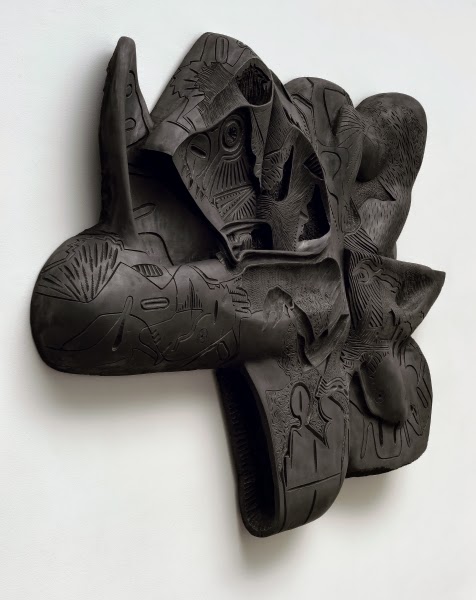{{{click on images to enlarge}}}
Portrait painting owes its most meaningful possible impact to our ability to discern character traits and emotional states by studying the human face. Indeed, a great portrait painter can engage us to draw upon a wide array of previous experience, insights and even knowledge of our society, the world and history, to grasp the representation of his/her subject. The great portraitist invites us to construct our own narratives around the subject and often compels us to assess and pass judgment on the subject he/she paints.
For example, one of my favorite portraits at the Met, El
Greco’s Cardinal Fernando
Niño de Guevara, shows us a professional torturer (he was appointed
Grand Inquisitor of Spain in 1599 and 250 – give or take a few – ‘heretics’ were
burned to death during the three years he ‘served’ in this position). We can
know so much about this cold-blooded and ambitious religious bureaucrat just
through the surreptitious gaze to his left that El Greco gives him. There is no
mercy in this calculating type of man, no milk of human kindness, but no
‘banality’ of evil either – he is resplendent in his church gowns and relishes
his power and opulence. In another room
at the MET, Rembrandt’s self-portrait from 1660 evokes compassion as we
perceive a deep sense of sorrow and resignation. While we look at this painting we can
experience a type of melancholic calm, searching ourselves to understand what
Rembrandt felt toward the end of his life. Holbein’s painting of Sir Thomas
Moore at the Frick is also one of my favorite portraits in New York and provides
an engaging model for a morally uncompromising life in a city where the Mayor
just called one of the worst political crooks in NY State history a “man of
integrity.” Moore is portrayed as rock solid in his commitment to an ethical
life and higher calling, but not devoid of warmth or kindness.
So what does it mean when a contemporary artist, in this
case Max Neumann at Bruce Silverstein Gallery, abandons all this? What effect do portraits have when they have
been darkened, made to appear completely two-dimensional in appearance, and
various facial features have been deliberately obscured through dark patches of
paint?
To some extent, perhaps Neumann could be repudiating the
history and purposes of portraiture. His art could be an attack on the limited
extent to which engagement through portraiture might be a meaningful or
transformative process for the viewer. Maybe he is even saying portraiture is wrong
and self-deceptive. What do you hope to derive from your self-righteous
insights about the political career of an Inquisitor painted by El Greco? How
did understanding Rembrandt’s sense of failure and loss change you? So you
admire Sir Thomas Moore while looking at a Holbein, OK, big deal, so what?
Maybe Neumann asks the question: what exactly do we want from portraiture (or
art in general), what do we expect to happen and why are we so satisfied with,
perhaps, so little? Are you engaging in
one process, while viewing art, while neglecting another more important
process? We could, therefore, possibly view Neumann’s work within a tradition
of anti-art. I tend to think, however,
that it’s not anti-art but an attempt to make us more aware of an
interpretative process we use often without questioning it.
The effect of seeing these large shadowy paintings comes
from our sudden inability to engage in our habitual process of scanning a face,
drawing upon our positive and negative experiences of others with similar facial
characteristics and making quick intuitive conclusions and judgments. So looking
at Neumann’s pieces we are frustrated and liberated at the same time. We are
rendered helpless and even powerless to engage in a process we are used to and
which provides not only gratification by also a certain amount of interpersonal
survival value. These subjects take on
the aura of Cycladic figurines. They are not to be engaged by us and will not
engage us because, perhaps, they are subjects who are diving deep into
themselves. Indeed, we can even think of Neumann’s portraits as being a part of
a type of religious tradition as these portraits become contemporary icons of
the contemplative or spiritually transformative process. Perhaps they represent
our concept of inner struggle and breakthrough as much as a serene-appearing
Buddha sitting under a tree might have represented this in other times and
cultures. This is still our concept of inner change – it comes in seclusion,
involving a closing off of the senses and a process of deep reflection. We don’t feel that we change through
transformative experience, but through a self-generated inner process of rigorous
self-examination.
Strangely, these portraits break down the barrier between
outer and inner world and point us back at ourselves. They say: "Don’t perceive
me, don’t analyze me, stop interpreting - dive into yourself as I am diving
into myself."
El Greco:





.jpg)















%2CMixedMediaOnCloth%2C67x26x9%2C2014.jpg)
%2CMixedMediaOnMesh%2C32x24x10%2C2014.jpg)




























